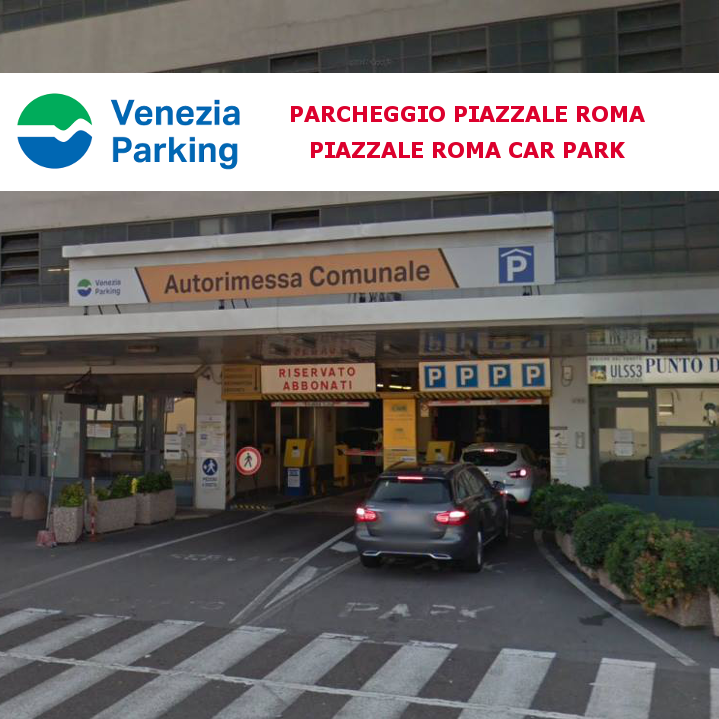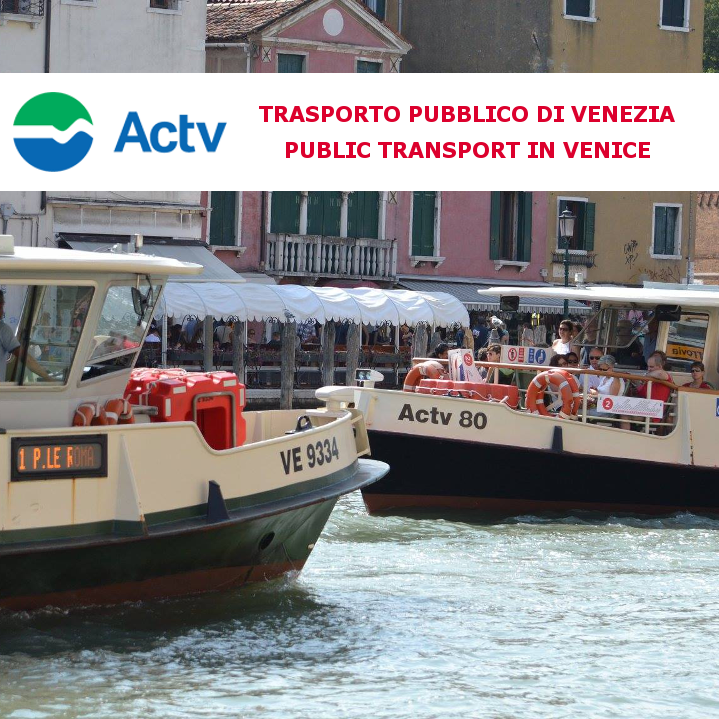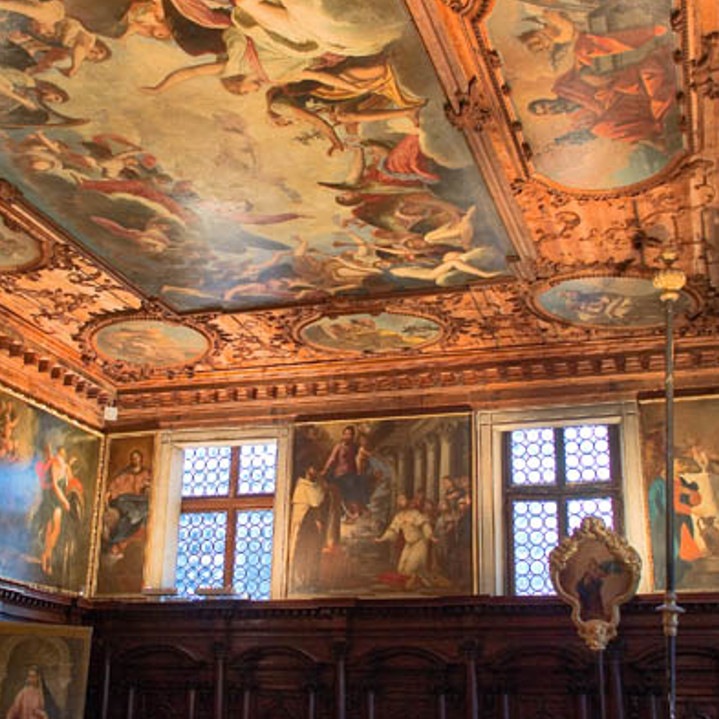You are here
Beauty mirrored in the water: discovering Giudecca and San Giorgio Maggiore
Beauty mirrored in the water: discovering Giudecca and San Giorgio Maggiore
This itinerary visits Venice from the waterfront of the south lagoon, exploring the islands of Giudecca and San Giorgio Maggiore and ending with a view over the city and its lagoon from the top of the 75-metre bell tower of San Giorgio Maggiore. You can start the itinerary at any stage along the route, so it can vary in duration and distance to suit your requirements.
Back in 2017, the City of Venice launched the #EnjoyRespectVenezia awareness campaign to promote sustainable tourism. Please ensure that you always behave responsibly and respectfully towards the city, taking particular note of the following:
- Do not stop and stand on bridges
- Keep to the right
- Only purchase goods from authorised retailers
- Use licensed tour guides.
- Duration: 4 – 4.5 hours + 1 hour visit to a museum or exhibition of your choice
- Distance: 8 km
- Mode: On foot and by vaporetto or other means of water transport
- Suggested period: All year round
- Suitable for children: Yes
- Disabled access: Partial
- Departure: Pizzale Roma / Santa Lucia Station – Santa Croce district
- Arrival: Island of San Giorgio Maggiore – San Marco district
- Districts: Santa Croce - Dorsoduro - San Marco
- Links with other itineraries: “Dorsoduro, art district: from Venetian origins to international contemporary art”. Link from the Church of Santa Maria dei Carmini or Fondamenta delle Zattere
Itinerary details
- Departure: Piazzale Roma / Santa Lucia Station – Scuola Grande dei Carmini
- Stage 1: Campo dei Carmini – Church of San Sebastiano
- Stage 2: Campo Santa Margherita – Church of Santa Maria dei Carmini
- Stage 3: Island of Giudecca - Church of Santi Cosma e Damiano
- Stage 4: Cloister of Santi Cosma e Damiano - Church of Santa Eufemia - Molino Stucky - Fortuny Showroom and Factory
- Stage 5: Church of Santa Eufemia - Corte dei Cordami - Former Cantieri Navali Officine Meccaniche di Venezia - Squero Crea
- Stage 6: Fondamenta San Giacomo - Church of Santissimo Redentore
- Stage 7: Church of Santissimo Redentore - Casa dei Tre Oci - Church of Zitelle
- Arrival: Church of Zitelle – Church of San Giorgio Maggiore - Bell tower of San Giorgio Maggiore - Fondazione Giorgio Cini
-
Sources
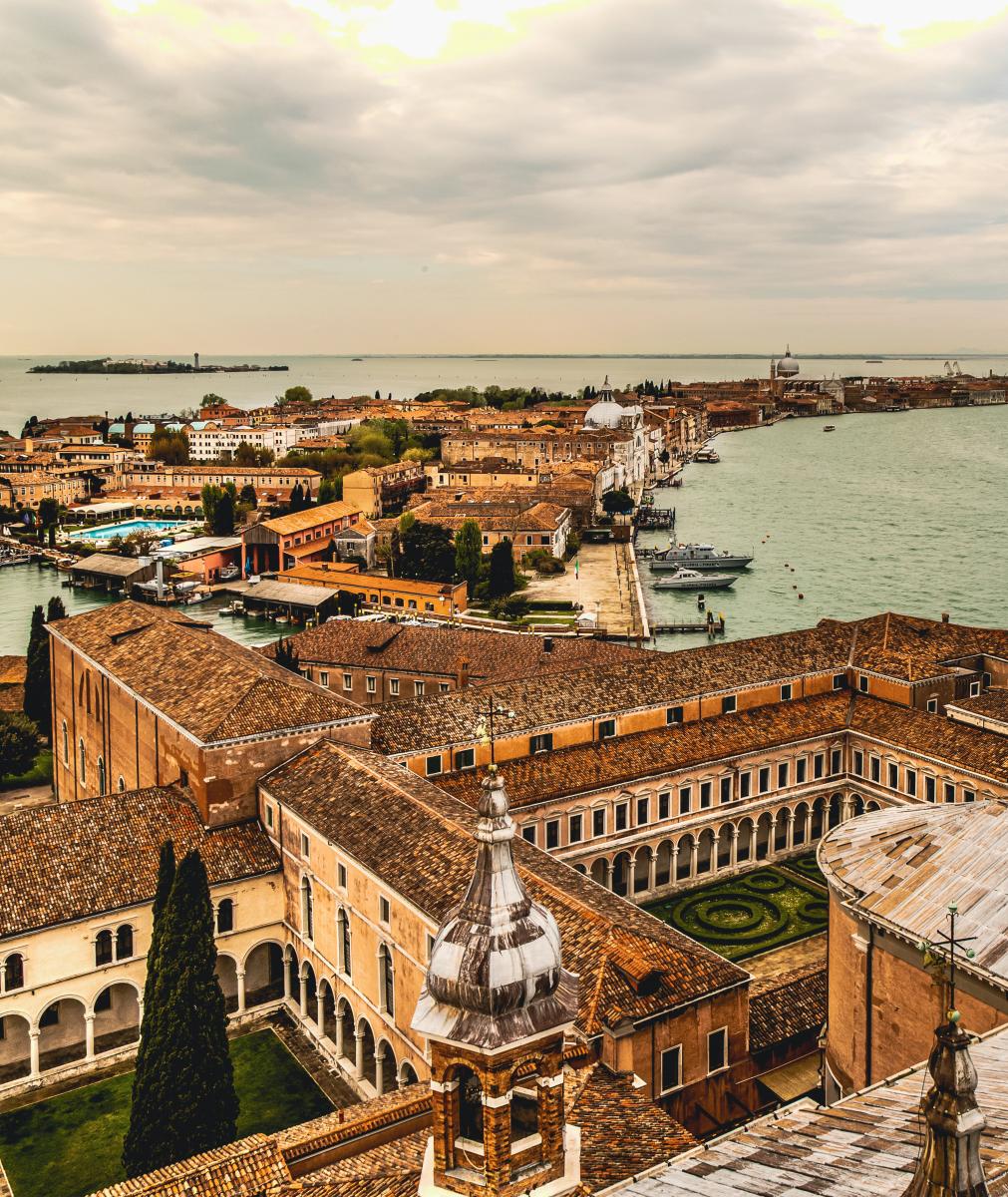
Giudecca pictured from the top of the bell tower of San Giorgio Maggiore
Departure: Piazzale Roma / Santa Lucia Station – Scuola Grande dei Carmini
The itinerary suggested begins or ends at Piazzale Roma or Santa Lucia Station, depending on which direction you take, bearing in mind that you can start it at any stage.
Once you reach Piazzale Roma, head right into Fondamenta Cossetti, where the Tre Ponti (Three Bridges), made of wood and stone, cross the three canals. Go straight on, taking Fondamenta dei Tre Ponti and then Fondamenta del Pagan. Cross the Ponte de la Cazziola, continue straight down Fondamenta Cazziola, cross the Ponte de Ca' de Rizzi and continue along Fondamenta San Marco. Going straight on, cross the iron bridge (Ponte dei Ragusei) and make your way to Calle Contarini, where you turn right into Calle dei Ragusei. At the end of the street, take slightly left into Fondamenta Foscarini and cross the Ponte Foscarini that leads directly to Campo dei Carmini.
Here you will find the majestic Church of Santa Maria del Carmelo, known as the Church of Santa Maria dei Carmini, built from the late thirteenth century onwards by the Carmelite Friars who arrived in the city in the middle of the same century. Although the church has undergone many changes over the centuries, its fourteenth-century plan is still evident inside, with three long aisles with simple capitals, supported by a double row of twelve monolithic columns. However, the building’s simple original elements (monolithic columns and wooden beams) coexist with rich seventeenth-to-eighteenth-century decoration with wooden panelling and gilded sculptures, which frame the twenty-four paintings with episodes relating to the Carmelite order, featured in succession above the arches.
Walking along the left side of the church and taking Calle della Scuola, you will reach the end of Campo Santa Margherita where you will find the Scuola Grande dei Carmini, the last of Venice’s scuole grandi, which were religious and charitable confraternities. The buildings have gone on to become monumental complexes rich in exceptional artistic treasures. The school was recognised as a “Scuola Grande” by the Council of Ten of the Venetian Republic in 1767. The brothers used to meet inside the building, in the Sala del Capitolo (chapterhouse), where Giambattista Tiepolo painted the nine canvases on the ceiling between 1739 and 1744, with the Virgin in Glory depicted in the centre.
From Campo dei Carmini you can join the “Dorsoduro, art district: from Venetian origins to international contemporary art” itinerary.
Useful information:
- Scuola Grande dei Carmini: Saturday and Sunday 11.00 a.m. – 5.00 p.m. Full-price ticket €7. See the official website for concessions and free admissions http://www.scuolagrandecarmini.it/
- Church of Santa Maria dei Carmini: Monday to Saturday 10.30 a.m. – 1.30 p.m. and 2.30 p.m. – 5.00 p.m. Admission €3 https://www.chorusvenezia.org/.http://www.scuolagrandecarmini.it/chiesa.php
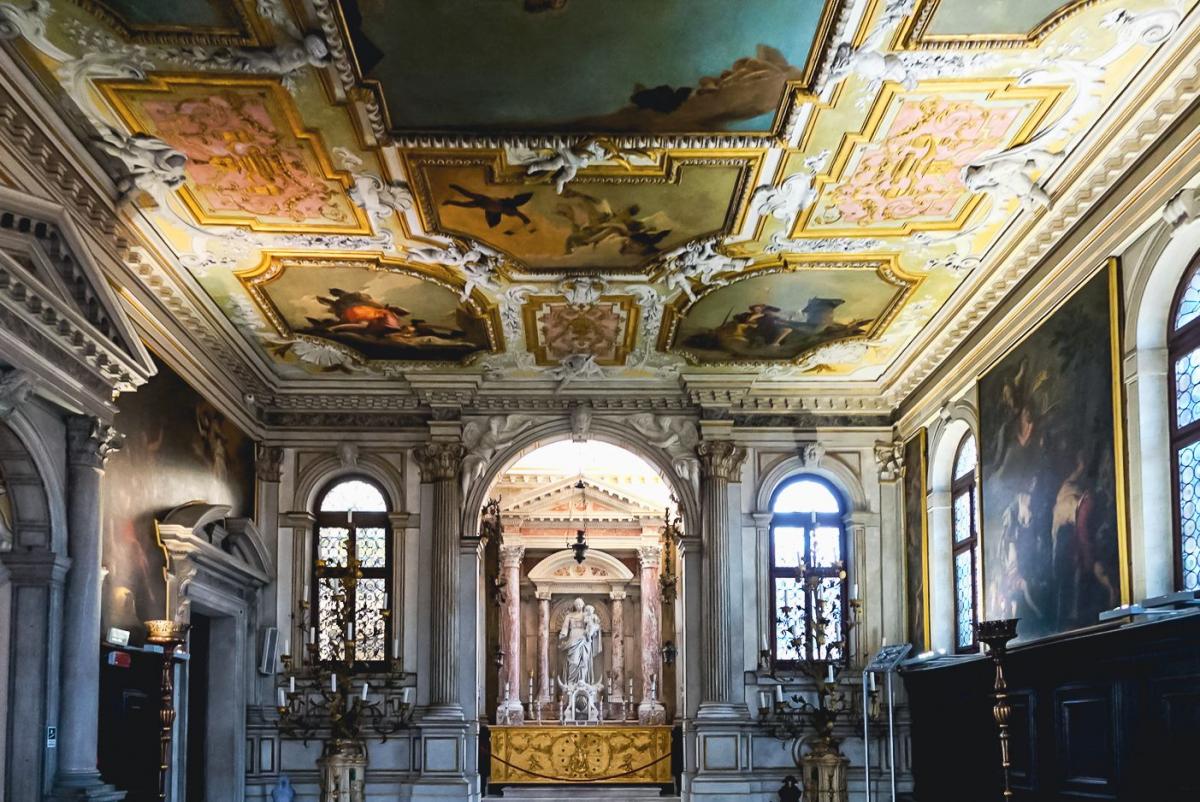
Scuola Grande dei Carmini, the last of Venice’s scuole grandi
Stage 1: Campo dei Carmini – Church of San Sebastiano
From Campo dei Carmini, turn left and walk along Fondamenta del Soccorso, go straight on, turning into Fondamenta San Sebastiano, and then cross the second bridge, Ponte de San Sebastiano, which will take you directly to Campo San Sebastiano.
The Church of San Sebastiano is one of the most important religious buildings in Venice, as it houses the largest cycle of sacred paintings by Paolo Caliari, known as Veronese, and also contains the painter’s mortal remains (on the left of the chancel).
Founded as part of the monastery by the Gerolamini friars in the fourteenth century, the church was extended several times between 1505 and 1548, under the direction of Antonio Abbondi, known as Lo Scarpagnino, giving it its current appearance.
The facade recalls the classical style, due to the presence of the large tympanum surmounted by the statues of three saints, with Sebastian in the centre, and by twin Corinthian columns framing the single-lancet windows and the circular rose window.
The side elevation and the bell tower are in a consistently simple style, reinforced by bare brick cladding.
The interior is a typical example of a Renaissance church, with a single aisle and a square chancel ending in a semi-circular apse, covered by a dome and flanked by two chapels. In the interior, the sacred space itself is preceded by an atrium occupied by the choir, which extends outwards with two wings to form a body under which six chapels open, three on each side.
There is also a small altar in the atrium with an altarpiece depicting St Nicholas by Titian.
Veronese's intervention took place in three phases; the first, in 1555, with the decoration of the flat ceiling of the sacristy, divided into sections, with The Coronation of the Virgin, Evangelists and Putti. The sacristy walls also feature a sequence of paintings from the workshop of Bonifacio Pitati, depicting scenes from the Old Testament.
Veronese later undertook the decoration of the church ceiling, which was also flat and divided into sections, with three Stories of Queen Esther. This work kept him occupied until 1556.
The second intervention took place between 1558 and 1559, with the frescoes in the upper part of the nave, the friars’ choir, the organ doors and the parapet, where he painted episodes from the Life of Jesus.
Finally, probably between 1559 and 1561, he painted the large altarpiece in the High Chapel with the Virgin with Putto in Glory and below St Sebastian, St Peter, St Catherine and St Francis. The two side canvases, depicting two episodes from the Life of St Sebastian, were completed in 1565.
The church also contains other works by Paris Bordone, Jacopo Sansovino, Jacopo Palma the Younger, Andrea Vicentino, Alessandro Vittoria and Andrea Schiavone.
It is interesting to note that in the large altarpiece, St Francis has the face of Fra’ Bernardo Torlioni, prior of the Gerolamini and a friend of Veronese.
To the left of the church facade, where the convent of San Sebastiano once stood, is the entrance to the Faculty of Literature and Philosophy of Ca’ Foscari University, designed by Carlo Scarpa between 1979 and 1980. The entire facade, revisited in Scarpa’s refined style, recalls the classicism of the adjacent church and enhances the beauty of the fifteenth-century effigy of St Sebastian.
A little further on is another church that is open to visitors: the Church of the Angelo Raffaele.
From Campo San Sebastiano, walk around the outside of the church, keeping right to make your way to Campazzo San Sebastian, where you will see Campo de l’Anzolo Raffaele, a raised square with two wells: the first, in Istrian stone, bears the date 15 July 1349 and the coat of arms of the Arian family, while the second well, located in Campo drio el Cimitero, is from the Renaissance period.
Angelo Raffaele is one of eight churches founded by the bishop of Oderzo, dating back to 1193 and subsequently demolished and rebuilt in 1618–1693. Inside, on the parapet of the eighteenth-century organ installed above the entrance from the rio (minor canal), there are five paintings attributed to Gian Antonio Guardi or to his brother Francesco.
It is interesting to note its positioning: the church was originally built diagonally from the canal and during the subsequent reconstruction, the decision was made to have the facade facing the Rio de l’Anzolo Rafael, with the aim of giving added urban identity to the two churches: Angelo Raffaele faces the rio and the Mendicanti quarter, while the facade of San Sebastiano faces San Barnaba. The church exterior remains unfinished, with only the main facade overlooking the rio completed with simple decoration.
Useful information:
- Church of San Sebastiano: Monday to Saturday 10.30 a.m. – 1.30 p.m. and 2.30 p.m. – 5.00 pm. Admission €3. https://www.chorusvenezia.org/
- Church of the Angelo Raffaele: Monday to Saturday 10:00 a.m. – 12.00 noon and 3:00 p.m. – 5:30 p.m.; Sundays and public holidays 9.00 a.m. – 12.00 noon http://events.veneziaunica.it/it/content/chiesa-di-san-raffaele-arcangelo
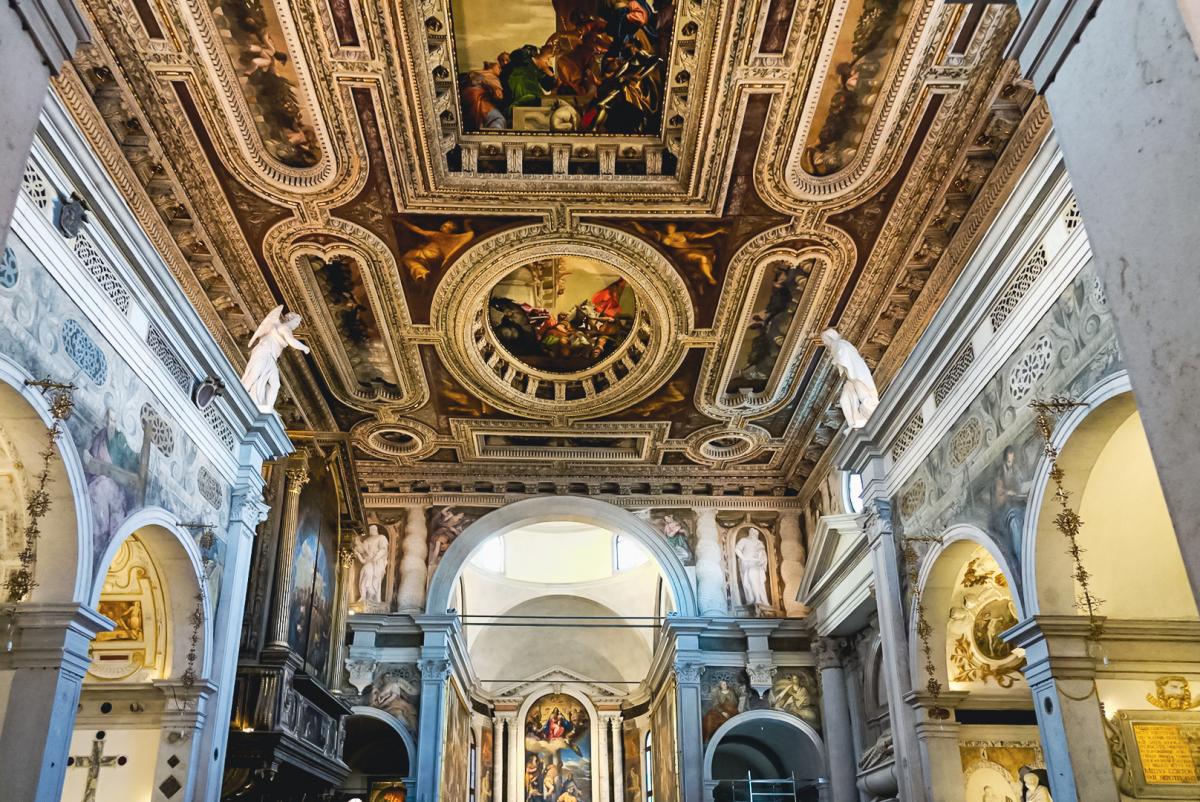
The Church of San Sebastiano houses the most important cycle of paintings by Paolo Caliari, known as Veronese
Stage 2: Church of San Sebastiano – Squero Domenico Tramontin & Figli - Fondamenta delle Zattere
From the Church of San Sebastiano, turn back, cross the Ponte de San Sebastian and rejoin Fondamenta de San Basegio on the right, before turning left into Calle de la Chiesa.
Near Campiello dei Morti, you will find the entrance to Squero Domenico Tramontin & Figli, one of the last boatyards in the city, which primarily specialises in building gondolas. If you go up to the Ponte Sartorio, you will be able to see the yard at work. The name squero derives from the word “squadra” or “squara”, used by carpenters to make boats. The Squero Tramontin is a classic Venetian boatyard: looking onto the canal; an angled surface sloping down into the water that allows flat-bottomed boats to be hauled in and launched; a “tesa” (a brickwork shed, closed on three sides, with a longitudinal plan and trussed roof) where the hulls are worked on indoors; an outdoor boat storage space and a warehouse for storing the planks used to make the boats. This squero was founded in 1884 by Domenico Tramontin, who had learned the art of gondola-building at the Squero Casal in Rio dei Servi, in Cannaregio, renowned for having introduced various important formal and constructive innovations to the gondola, which proved so effective that they are still in use today. The boatbuilder Roberto Tramontin, Domenico’s grandson, passed away in 2018 and his daughters Elena and Elisabetta took over the family business: a story that has continued for four generations.
Wood was an essential raw material for the Serenissima, used to build ships in the Arsenale and smaller boats in the squeri, but also to consolidate banks and foundations, for heating and for glassworks. The most valuable timber came from woods on the Venetian-Friulian plain and was transported to Venice on large rafts that travelled down the rivers:
• Beech trunks from the Cansiglio Forest, nicknamed the “oar” forest, were used to make long oars for galleys;
• conifers came from Cadore, Vanoi or Primiero;
• firs from the Asiago Plateau reached Venice along the River Brenta;
• timber from the Vicenza plain arrived in Chioggia via the River Bacchiglione;
• wood from the Lessini mountains, the Verona area and the Tyrol reached the lagoon along the River Adige.
To continue the itinerary, retrace your steps along Calle de la Chiesa, turn left into Campo San Basegio, cross it diagonally and take Calle del Vento. Here you will arrive at the beginning of Fondamenta delle Zattere, a long fondamenta (canal bank) that extends from San Basilio and runs along the entire Canale della Giudecca, ending at Punta della Dogana. Its name derives from the term “zattere” (rafts), because this was the point of arrival for the logs and timbers transported down the rivers by raft. Please note that you can join the “Dorsoduro, art district: from Venetian origins to international contemporary art” itinerary at this point.
From here, take the vaporetto from the San Basilio B landing stage to the island of Sacca Fisola, where a short walk will take you to the island of Giudecca. Or, from the San Basilio landing stage, take the vaporetto directly to Giudecca (Palanca stop), continuing on to the island of San Giorgio Maggiore.
Useful information:
- Squero Domenico Tramontin & Figli: for guided tours, visit the official website https://www.tramontingondole.it/
- Vaporetto: San Basilio B stop: line 2 towards Sacca Fisola B (3 minutes by vaporetto)
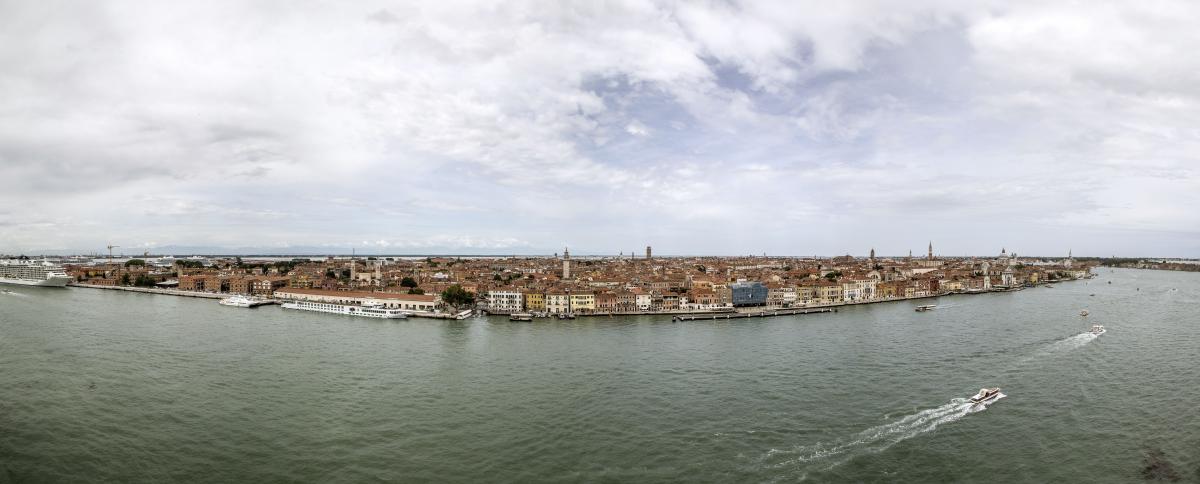
Stage 3: Island of Giudecca - Church of Santi Cosma e Damiano
Cross the Canale della Giudecca by water transport to reach the island of Giudecca, also called Spinalonga because of its narrow and elongated shape.
The origin and meaning of the name “Giudecca” is unclear. According to some, this name derives from the many Jews who lived in this area before the fourteenth century, while others believe the name “Giudecca” originates from the word Zudegà – in Italian “giudicato” (judgement) – with which land was granted to certain noble families in the ninth century as compensation for their previous exile and banishment from Venice.
The island of Giudecca was an ideal place for stores and warehouses of goods from the port of Malamocco and from the mainland, and also had a commercial, artisanal and aristocratic life of its own. Gardens, vegetable plots, monasteries, convents and literary and philosophical academies were built on the island’s extensive grounds, and Venetian patricians used to build their villas here; known as “casini”, they were designed in the style of town and country houses, with large gardens and vegetable plots to the south, and were used for short stays, especially in summer. In the early nineteenth century, with the suppression of religious orders and the fall of the Serenissima, the island became the site of barracks, prisons, factories and working-class neighbourhoods. Numerous interventions over the years have sought to restore and regenerate certain areas of the island, which are now home to large numbers of workshops, showrooms, galleries, foundations and contemporary exhibitions.
From the Ponte dei Lavraneri, continue straight ahead along Calle Priuli, cross Campiello Priuli and the Ponte Priuli, then continue down Fondamenta de le Convertite, home to the church and former convent of Santa Maria Maddalena, which has housed the women’s prison on Giudecca since 1857. At the end of the fondamenta, cross the Ponte San Cosmo or Ponte del Lagoscuro and make your way to Campo San Cosmo, where you’ll find the former church of Santi Cosma e Damiano. Construction work on it began in 1481 and it was consecrated in 1583, before both the church and the adjacent convent were closed for worship in 1800. Over the years, the church has been used as a barracks, hospital and salt factory. In 1886, it became a yarn factory and was later converted into a knitwear factory owned by the German Herion family.
The monastery complex was leased to the Municipality of Venice in the 1990s. Today, part of it houses public residences, offices and large rooms, while the cloister houses twelve craft activities. We recommend visiting the cloister of Santi Cosma e Damiano, which has now become an arts and craft centre that is open to the public and can be accessed through an iron door on the right after the church. The craft workshops around the portico are dedicated to metalworking, glass decoration, essential oil and perfume production, graphic design, paper production and decoration, bookbinding and restoration, mask-making and forms of contemporary craftsmanship linked to new information technologies.
Useful information:
- Cloister of Santi Cosma e Damiano – arts and craft centre: Monday to Sunday 10.00 a.m. – 7.00 p.m. https://www.comune.venezia.it/it/content/ss-cosma-e-damiano
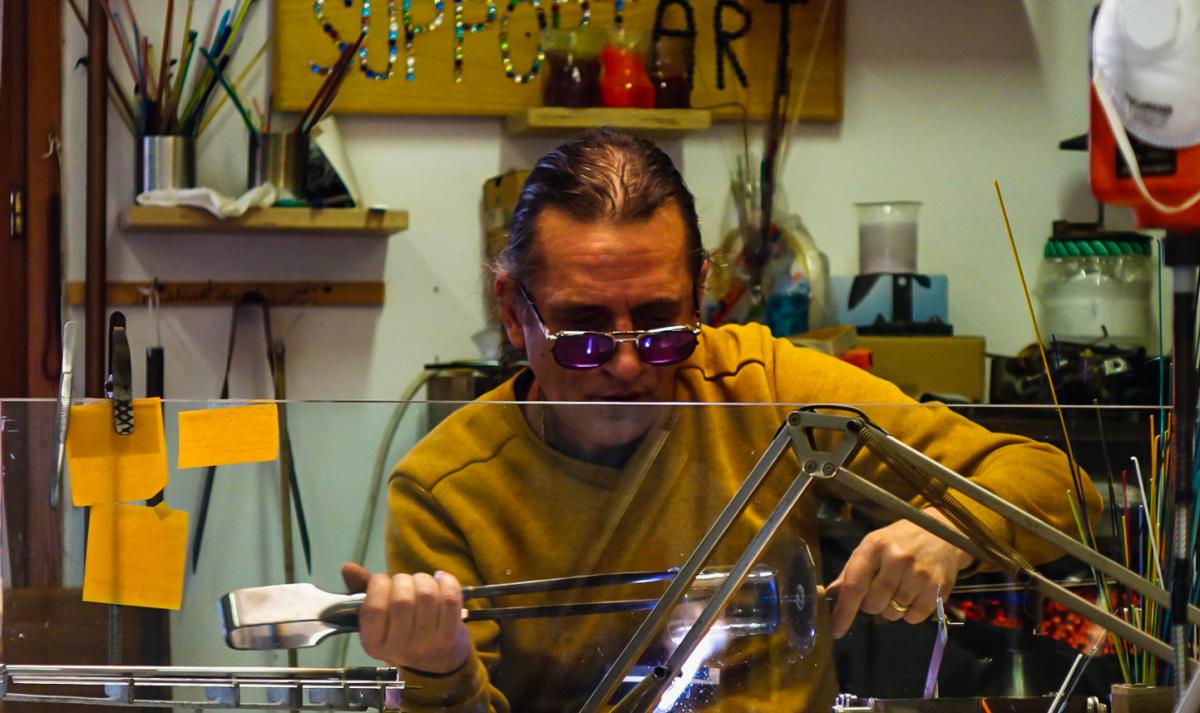
One of the craftsmen with his own workshop in the cloister of Santi Cosma and Damiano
Stage 4: Cloister of Santi Cosma e Damiano - Church of Sant'Eufemia - Molino Stucky - Fortuny Showroom and Factory
Exit the cloister of Santi Cosma e Damiano and turn left into Campo San Cosmo, then head right for Fondamenta del Rio de Sant'Eufemia (the fondamenta to the right of the Ponte San Cosmo or Ponte del Lagoscuro). Continue straight on until you reach the Canale della Giudecca and you will find Campiello Sant'Eufemia immediately on your right.
This square is dominated by the imposing church of Sant’Eufemia, the first to be founded on the island, originally dating back to the ninth century and remodelled several times in the sixteenth and eighteenth centuries. The left portico dates back to the nineteenth century and was built with Doric columns from the ancient church of Santi Biagio e Cataldo, which has since been demolished. The interior features a Venetian-Byzantine plan with three aisles, and houses a number of ancient works, while the ceiling stands out for its series of frescoes illustrating the story of St Euphemia. The chapel of Sant’Anna, to the right of the high altar, houses the urns containing the body of the Blessed Giuliana da Collalto, while the original coffin is held in Museo Correr. We recommend visiting the small cloister, which can be accessed from the aisle on the right.
From here, we suggest making your way to the former Molino Stucky: cross the Ponte di Sant’Eufemia on the left and walk the entire length of Fondamenta San Biagio, with its fifteenth-to-eighteenth-century houses and buildings. This canal bank was consolidated in order to allow large ships to dock, and trees were also planted here in the late nineteenth century. A number of important industries have been based along the fondamenta in the past, including: the Pivato hair product factory, the former brewery, the fifteenth-century Vendramin warehouses used to store salt and coal, and the Fortuny textile factory, the only one still in business today. At the end of the fondamenta, you will notice the former Molino Stucky, a vast industrial complex made up of several buildings in an area once occupied by the thirteenth-century convent of Santi Biagio e Cataldo, demolished in 1882. In 1896, the entrepreneur Giovanni Stucky decided to extend the factory by constructing an enormous exposed brickwork building reminiscent of Nordic architecture. The factory became a symbol of the city’s industrial expansion, employing more than 1500 workers until production ceased in 1954. In the 1990s, work began to restore the factory, followed by a fire in 2003 that devastated part of the building. It was later turned into a luxury hotel and conference area.
This fondamenta is also home to one of Giudecca’s real treasure: the Fortuny Showroom and Factory, open by appointment.
At the end of the fondamenta, you will see the Fortuny Showroom and Factory, founded by Mariano Fortuny y Madrazo, born in Spain to a renowned family of artists. Fortuny moved to Venice in 1889, and the workshop he initially worked in with his wife Henriette Negrin - his working partner and artistic inspiration - was located in Palazzo Pesaro degli Orfei, now known as the Museo Fortuny, in Campo San Beneto (included in the “A walk through the Campi and Calli: from Cannaregio to San Marco through the Jewish Ghetto” itinerary). Later, in 1921, in order to accommodate its large-scale production, Fortuny moved the manufacturing process to the current factory on Giudecca. Fortuny was also interested in science, art and technology, and he invented pleating and innovative printing and gilding procedures that earned him the reputation of being an “alchemist dyer”, as he was described by Gabriele d’Annunzio. The New York interior designer Elsie McNeill Lee saw Fortuny’s fabrics at the Musée Carnavalet in Paris and fell in love with them. She met the artist and became the sole US distributor for his fabrics, opening a shop on Madison Avenue in New York. In addition to the showroom, it is also possible, by appointment, to visit the beautiful garden that forms part of the complex, restored by Elsie McNeill Lee in the 1950s.
Useful information:
- Church of Sant’Eufemia: https://donboscogiudecca.wordpress.com/visitare-la-chiesa/ https://donboscogiudecca.files.wordpress.com/2021/03/opuscolo-santa-eufemia-12-07-2020.pdf
- Fortuny Showroom: open by appointment Monday to Friday 10.00 a.m. – 1.00 p.m. and 2.00 p.m. – 6.00 p.m. https://fortuny.com/
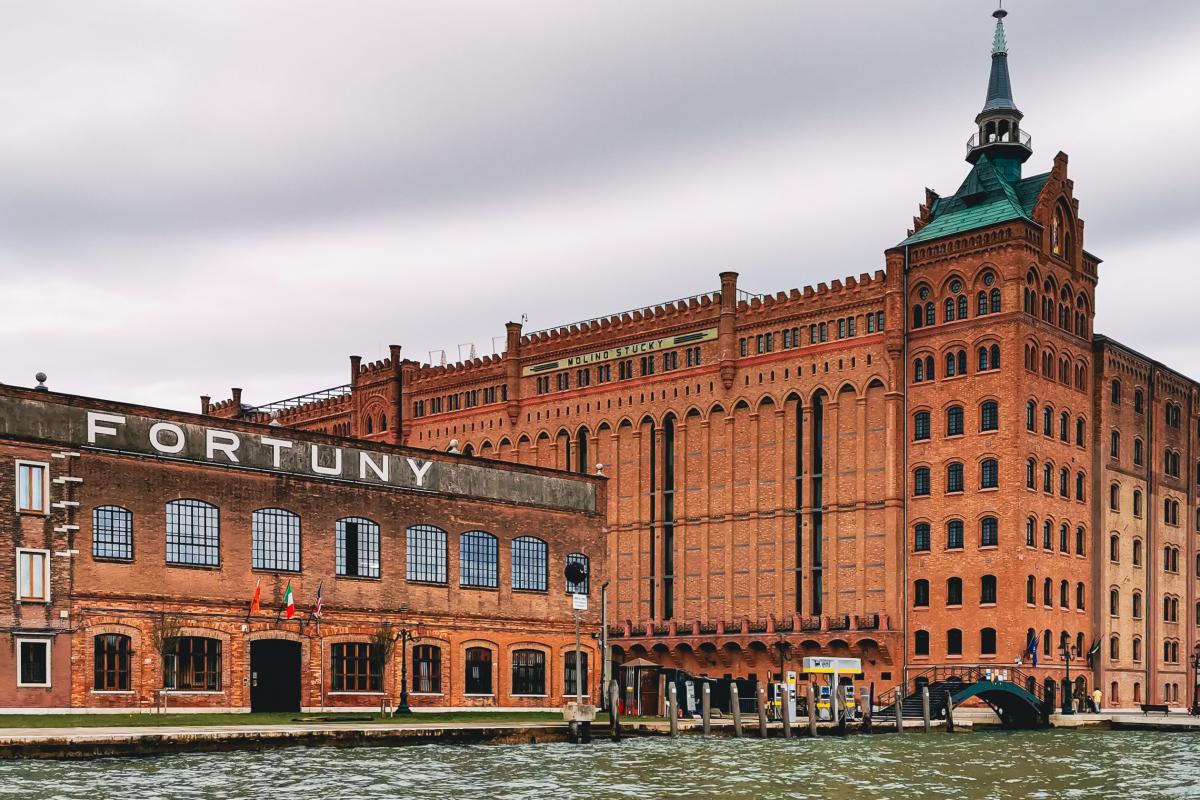
On the left, the Fortuny Showroom and Factory and on the right, the former Molino Stucky
Stage 5: Church of Sant'Eufemia - Corte dei Cordami - Former Cantieri Navali Officine meccaniche di Venezia - Squero Crea
From Fondamenta San Biagio, go back to the Church of Sant’Eufemia and continue straight on along Fondamenta Sant’Eufemia, skirting the Canale della Giudecca. Shortly after the ACTV Palanca stop, turn right into Calle del Forno (near a tobacconist’s), then go straight ahead through Campiello del Forno until you reach Corte dei Cordami.
The popular Corte dei Cordami is long and narrow in shape. It was here, during the time of the Venetian Republic, that the games of football and bull hunting (or rather ox hunting) took place. Bull hunting in the Venetian squares took place from the first day of Carnival until the last Sunday. It involved fighting between dogs and bulls, with two or more “tiratori” holding the latter by the horns with ropes. Furthermore, as the name “Corte dei Cordami” suggests, this courtyard was the place where rope-makers worked outdoors making ropes and lines for the ships, including large hemp cables used for mooring and towing, consisting of several ropes twisted together. Looking onto the courtyard is a series of terraced houses with large chimneys, probably dating from the seventeenth century: an example of Venetian social housing. In the centre of the courtyard is a hexagonal well dating back to the sixteenth century. The two sides are decorated with two tondi, chiselled inside a halo of rays, which probably once featured the Bernardinian monogram IHS (an abbreviation of “Iesous”, meaning Jesus in ancient Greek), suggesting that it came from a suppressed convent on the island. It should be remembered that in the city wells were made by pozzeri (well-makers), who handed down the secrets of building techniques from father to son. From the thirteenth century onwards, they were present in the Scuola dei Mureri, a guild school that brought together those involved in masonry work. Redevelopment work has been underway on the former Gaggio carpet factory here in Corte dei Cordami since 2003, with the aim of creating new spaces for public use.
At the end of Corte dei Cordami, continuing straight on, you will come to Corte Grande (where there is a small playground), while on the left you will see the first of the buildings comprising the former Junghans precision instrument factory. This factory was founded in 1878 and has been transformed several times over the years. It is now a residential complex. The watch factory originally occupied a large area of Giudecca, extending from Corte Grande to Ponte Longo, and continued to produce watches until the Second World War. During the war, the factory was forced to switch its production to fuses for military devices until it closed down in 1971. In 1995, the architect Cino Zucchi won the tender for the redevelopment of the area, creating a new residential district of subsidised housing, for both university students and the open market.
From the playground in Corte Grande, turn left into Calle de le Scuole and cross the Ponte de le Scuole, making your way to Campo Junghans, where the main factory building is located. This semi-circular building was erected in 1943 following the demolition of the sixteenth-century convent of Sant’Angelo dei Carmelitani.
Go straight across the square until you come to the opposite canal via Calle Junghans. Turn left into Fondamenta Sant’Angelo, head in the direction of Campo de la Sponza, and continue straight on until you get to the Ponte Sant'Angelo. Go right along Calle de le Erbe, until you reach the Canale della Giudecca. Turn right onto Fondamenta del Ponte Piccolo, cross the Ponte Longo and continue along Fondamenta San Giacomo.
At the very start of the fondamenta you will see three long, low buildings, built in 1906. No. 211 marks the entrance to the former Cantieri Navali Officine Meccaniche di Venezia (CNOMV), an area that extends from the Canale della Giudecca to the South Lagoon. These shipyards remained in business until 1960. After years of abandonment, the Municipality of Venice redeveloped the area in 1988, preserving its original functions and typical features. The former CNOMV premises then became home to the Consorzio della Cantieristica Minore Veneziana, a consortium of around a dozen companies linked to the production of typical lagoon boats.
Part of the complex is the Cantiere Nautico “Crea”, which designs and builds typical Venetian boats and specialises in restoring vintage boats. Its owner, Gianfranco Vianello, known as “Crea”, was one of Venice’s finest competitive rowers, so much so that he earned the nickname “re del remo” (king of the oar), a title awarded to the rower who wins five consecutive editions of the Historical Regatta. After his career was over, Gianfranco began working as a shipwright.
It is interesting to note that this shipyard differs from a typical Venetian squero, which normally consists of a “tesa” (shed) facing the canal and an angled surface descending into the water for launching boats and hauling them in, while in the Crea yard, the shed is covered and equipped with a crane for lifting boats.
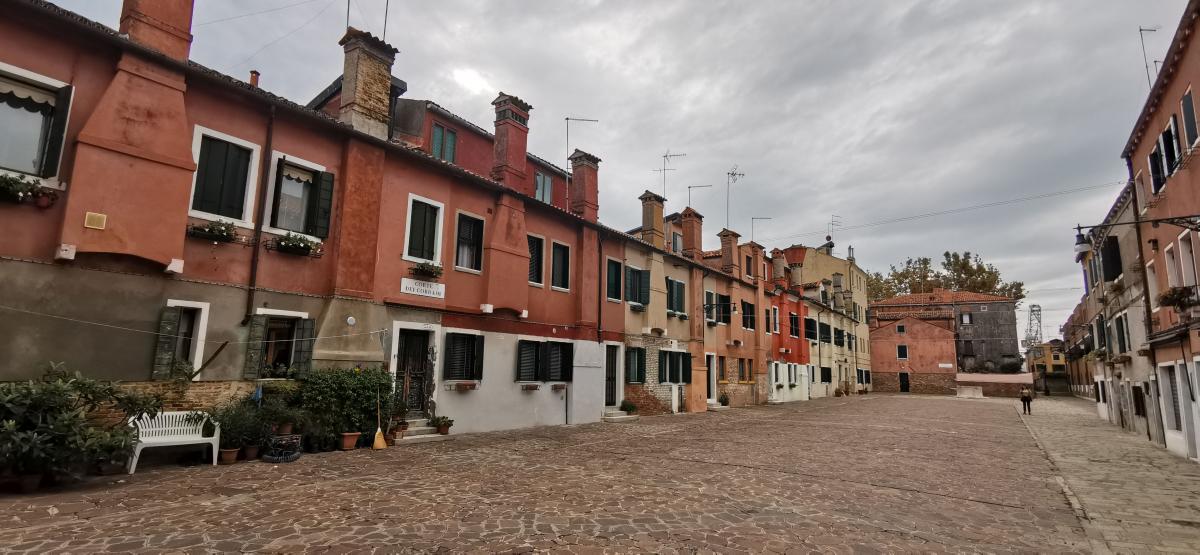
Corte dei Cordami
Stage 6: Fondamenta San Giacomo - Church of Santissimo Redentore
From Fondamenta San Giacomo, go straight on until you reach Campo San Giacomo, once home to a convent of the same name that was demolished in 1837. To reach the Church of the Santissimo Redentore, go all the way along Fondamenta San Giacomo, the location for a number of scenes in the 2017 film Finché c'è prosecco c'è speranza, directed by Antonio Padovan.
Once you reach Campo del Santissimo Redentore, you will find yourself in front of the Church of the Santissimo Redentore, one of the most famous and venerated religious buildings in Venice. Since 1578, the Festa del Redentore has been celebrated here every third Sunday in July as a sign of liberation from the plague: a votive bridge connects the two banks of the Canale della Giudecca and a night-time fireworks display is staged over the basin of San Marco.
In 1576, at the height of the plague that lasted from 1575 to 1577, the Venetian Senate decided to build a votive church dedicated to the Redeemer. We do not know why they chose Giudecca, which is well away from the centre of Venice. However, it is worth noting that the church is clearly visible from most of the city, thanks to its position. Andrea Palladio, who was commissioned to design the building, decided to construct it over the small church of Santa Maria degli Angeli, used by the Capuchin friars. The Capuchin friars agreed to this as long as their wishes were respected with regard to allowing no burials of noblemen and patricians, in keeping with their vow of poverty. Palladio died without being able to finish the work, which was completed by Andrea Da Ponte.
The imposing dimensions of the church mean that it can only be seen in its entirety from a distance. A majestic staircase characterises the entire central section of the facade, resembling a bas relief even from a distance. The façade is characterised by tympanums, interrupted by semi-columns and the horizontal element that contains it geometrically. The church houses works by Francesco and Jacopo Bassano, the school of Jacopo Tintoretto, Girolamo Campagna, Palma the Younger, Paolo Veronese, Alvise Vivarini and Domenico Tintoretto. It is interesting to note that the extensive vegetable gardens belonging to the Capuchin convent (occupying approximately one hectare) remain to this day, and are made up of rows of vines, cypresses and beehives. The gardens are also planted with numerous fruit trees, vegetables, aromatic and medicinal herbs.
Useful information:
- Church of the Santissimo Redentore: Monday to Saturday 10.30 a.m. – 1.30 p.m. and 2.30 p.m. – 5.00 p.m. Admission €3. https://www.chorusvenezia.org/
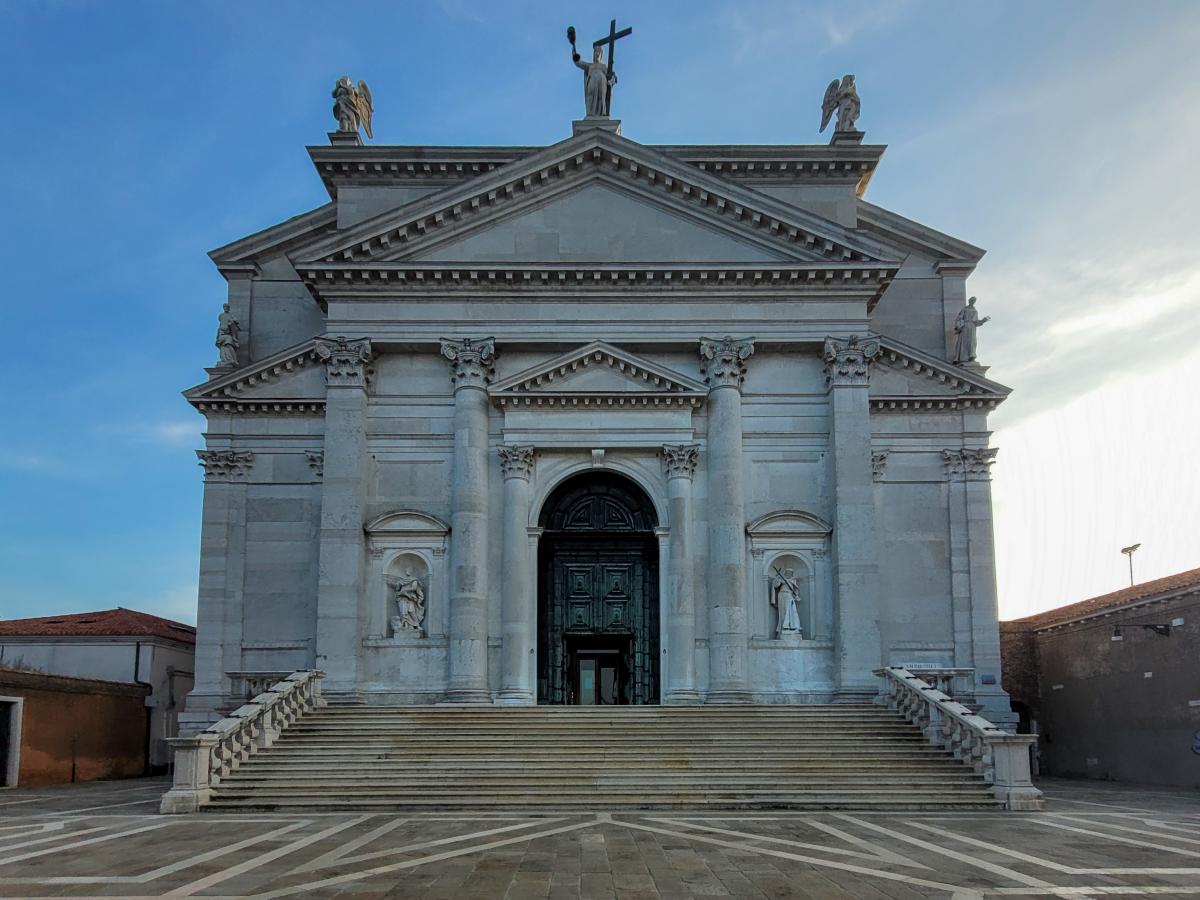
The Church of the Santissimo Redentore, one of the most famous and venerated religious buildings in Venice
Stage 7: Church of Santissimo Redentore - Casa dei Tre Oci - Church of Zitelle
From the Church of the Santissimo Redentore, continue straight ahead, admiring the spectacular view of Fondamenta delle Zattere and Punta delle Dogana on the opposite side of the Canale della Giudecca. Once you have passed the Zitelle vaporetto stop, you will see the Casa dei Tre Oci on your right in Fondamenta de le Zitelle.
The building was declared a property of historical and artistic interest in 2007 by the Regional Directorate for Veneto Cultural and Landscape Heritage and is the result of various architectural trends, from the traditional Venetian home and warehouse to twentieth-century avant-garde. Built in 1913, when Giudecca was experiencing major architectural and urban change, the Casa dei Tre Oci was originally the home and studio of the artist Mario de Maria, who designed it and personally supervised its construction. Later, his son Astolfo, a painter like his father, lived there with his wife Adele. It was a place of artistic and cultural production from the very start, and was also used as a studio by artists who participated in the Biennale and by intellectuals passing through Venice. Thanks to the hard work of Adele and Giulio Macchi, whom Adele married after Astolfo’s death, the Casa dei Tre Oci hosted internationally renowned figures, from Vittore Grubicy to Hundertwasser, Peggy Guggenheim’s daughter, Sciltian, Giorgio Morandi, Lucio Fontana and Dario Fo, who used it as a workshop for his 1985 "Hellequin, Harlekin, Arlekin, Arlecchino".
The building has three floors, but the three huge òci (“eyes” in Venetian), namely large ogival windows overlooking the Canale della Giudecca and the basin of San Marco, underscore the importance of the piano nobile. There is a central mullioned window framed by neo-Gothic decorations on the second floor. Purchased by the Fondazione di Venezia, the Casa dei Tre Oci became an exhibition space open to the public in 2012 following extensive restoration work.
Continuing a little further along Fondamenta de le Zitelle, you can admire the Church of Santa Maria della Presentazione on the right, also known as Le Zitelle. It was built at the behest of the Jesuit Benedetto Palmi to assist poor girls. They were taught sewing or the art of Venetian lace in the hospice, so that they could support themselves. According to most scholars, construction began in around 1579–80 based on a design by Andrea Palladio, but the building work itself was supervised by Giacomo Bozzetto and Bortolomeo Manopola. Together with the churches of San Giorgio and the Santissimo Redentore, the Church of the Zitelle represents the third Palladian construction in the project to regenerate Giudecca and the island of San Giorgio Maggiore. The original idea was probably inspired by a model of a votive temple with a central plan, which was then amended during the course of the work due to the limited space available and the ecclesiastical institution’s limited financial resources.
The church facade features two tiers with two windows in the first tier and a large semi-circular window in the second tier, higher than the two wings of the hospice, enclosed by a tympanum. Two small bell towers are placed symmetrically above the tympanum, while the building is topped by a large dome with an imposing lantern.
The polygonal interior is enriched by sculptures and precious paintings, including:
- The Presentation of the Virgin at the Temple by Francesco Bassano, on the high altar;
- above the altarpiece, a copy of Jacopo Sansovino’s lunette depicting the Madonna and Child with Two Angels, also known as the Madonna of the Kiss (the original is in the Galleria Franchetti at Ca’ d’Oro in Venice);
- on the right altar, a work by Palma the Younger entitled Prayer in the Garden;
- on the left altar, a work by Antonio Vassillachi known as Aliense, entitled Madonna and Child with St Francis with a portrait of the procurator Federico Contarini.
Useful information:
- Casa de Tre Oci: open every day from 11.00 a.m. – 7.00 p.m. (closed on Tuesdays). Full-price ticket €13. See the website for information about current exhibitions https://www.treoci.org/it/
- Church of the Zitelle: https://www.gioiellinascostidivenezia.it/i-gioielli/chiesa-delle-zitelle/
- Vaporetto to San Giorgio Maggiore: Zitelle stop, line 2 towards San Giorgio Maggiore (3 minutes by vaporetto – one stop).
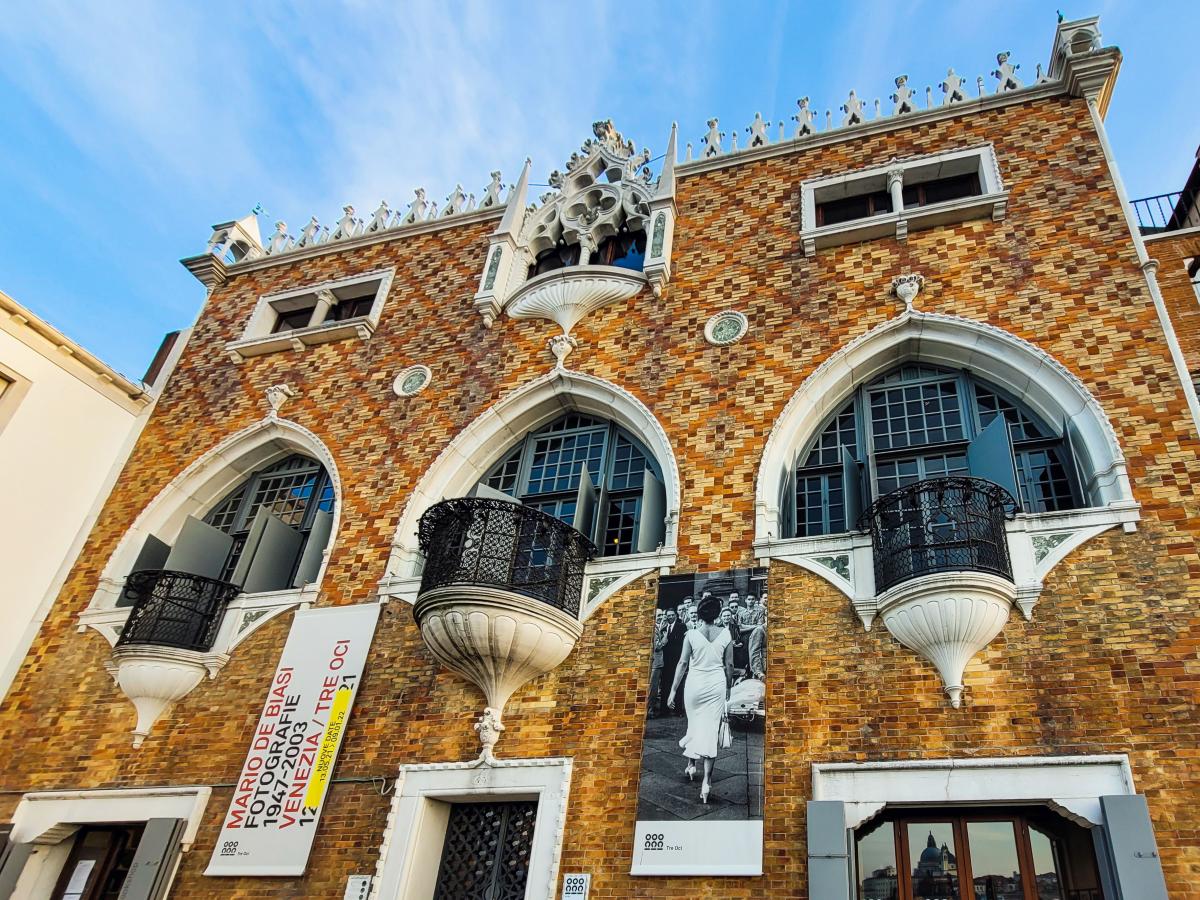
Casa dei Tre Oci
Arrival: Church of the Zitelle – Church of San Giorgio Maggiore – Bell tower of San Giorgio Maggiore – Fondazione Giorgio Cini
You need to take the vaporetto to reach the island of San Giorgio Maggiore from Giudecca. From the Church of the Zitelle, head left to the vaporetto berth – Zitelle stop – and take line 2 towards the island of San Giorgio Maggiore.
The island of San Giorgio Maggiore, which is part of the San Marco district, is situated opposite Piazza San Marco and is separated from Giudecca by the small Canale della Grazia. Its position offers a breath-taking view of Venice, the Lido and Sant’Elena. The island, once known as “Isola dei Cipressi” (Island of Cypresses), was owned by the doges, who built the first church dedicated to St George there in the ninth century. In 982, the doge Tribuno Memmo donated the whole island to the abbot Giovanni Morosini to found the Benedictine abbey, which the doges visited every Christmas night to celebrate the solemn mass, since the church was also dedicated to St Stephen. It should be remembered that Cosimo I de’ Medici spent part of his exile here and had a library built, which was later destroyed in 1614. Following the reformation of the religious orders, a decision was made to rebuild the entire complex. However, the work, which began in the fifteenth century, was never completed. In 1565, Andrea Palladio presented a design for the new church.
The geometric paving of the square leading to the abbey of San Giorgio Maggiore, designed and begun in 1566 by Andrea Palladio himself, who supervised the works until his death in 1580, was completed in 1589. The work on the facade continued from 1607 to 1611, in keeping with Palladio’s design. Four large columns lean against the facade at the central nave, incorporating the portals and two niches with the statues of St Stephen and St George. The columns support a large pediment with a triangular tympanum, which bear statues of the Redeemer and two angels. The interior has all the typical features of a convent church, namely a Latin cross plan with three aisles, transept, chancel and choir. However, they are arranged in an unusual fashion: the nave is narrow at the front and extends into the apsidal arms of the transept; the dome is therefore located in the centre of both the lengthways and crossways body.
Next to the church is the former monastery, founded by the Benedictines in the tenth century and subjected to numerous reconstructions and alterations. A monumental square entrance leads into Palladio’s Refettorio (Refectory), with a huge door onto a small room composed of two pink marble sinks set in Corinthian aedicules. The monastery houses the “Sala del Conclave” (Room of the Conclave). This room, built as the night choir for the monastery, has gone down in history due to the conclave of 1800 that resulted in the Benedictine Barnaba Chiarimonti being elected to the Papal Throne under the name of Pius VII. It is worth noting the pictures nailed to the choir seats, which feature the names of each cardinal who took part.
Palladio also designed the first cloister, which can be accessed directly from the parvis, surrounded by porticoes, with arches supported by columns, above which are windows crowned with tympanum and arches. This evocative setting also houses works by Tintoretto and Veronese. Later, in the first half of the seventeenth century, Longhena completed the library, the staircase and the small guest quarters. The later “Chiostro dei Cipressi” (Cypress Cloister), designed by Giovanni Buora, was built by his son Andrea.
We suggest climbing the bell tower of the Abbey of San Giorgio Maggiore, on the eastern side of the church. Built to a design by Benedetto Buratti from Bologna in 1791, following the collapse of the earlier fifteenth-century bell tower in 1773, it measures 75 metres high and culminates in an Istrian stone belfry, surmounted by a cylindrical body supporting the conical spire. There is a rotating angel at the top.
A lift transports visitors up to the belfry terrace in the bell tower. From here you can enjoy the most comprehensive view of Venice, incorporating the basin of San Marco, the Canal Grande, the Canale della Giudecca, the Lido, Sant’Elena and a number of minor islands in the southern lagoon. In the distance, to the north and north-west, you can see the Alps and, to the west, the Euganean Hills.
It is also worth noting that the monumental complex of the former Benedictine monastery of San Giorgio Maggiore is home to the headquarters of the Fondazione Giorgio Cini, an internationally renowned cultural institution that deals with research and organises conventions, art exhibitions, shows and concerts. Following the impressive restoration of the island, the ancient Benedictine monastery became a centre for educational, cultural and social activities. Since this initial regeneration project in the 1950s, a large number of spaces in the monumental complex have been restored and returned to the public:
- the Centro Marinaro is now home to Le Stanze del Vetro: a permanent exhibition space for promoting the study and appreciation of twentieth-century and contemporary glass art;
- the Centro Arti e Mestieri is now home to Le Sale del Convitto, which in the nineteenth century housed the customs warehouses, before being occupied by the Convitto Scolastico (a boarding school) from 1952. Today they are open to the public as an exhibition centre with temporary exhibitions;
- lo Squero, an ancient workshop for repairing boats, has been transformed into a modern Auditorium.
Inside the foundation you can visit the Chiostro Palladiano (Palladian Cloister), followed by the Chiostro Buora o dei Cipressi (Buora or Cypress Cloister), which is the older of the two; the Cenacolo Palladiano (Palladian Cenacle), with a facsimile of Paolo Veronese’s Wedding at Cana produced by Factum Arte; the Sala delle Fotografie (Hall of Photographs); the Scalone (Monumental Staircase) and the Biblioteca del Longhena (Longhena Library); the Nuova Manica Lunga, a former Benedictine dormitory transformed into a library by Michele De Lucchi; the Labirinto Borges (Borges Labyrinth), designed by Randoll Coate and inspired by Borges’s short story ‘The Garden of Forking Paths’, which recently opened to the public.
This is the end of the itinerary. From here, you can take vaporetto line 2 in the direction of San Marco-San Zaccaria or in the direction of Piazzale Roma-Tronchetto.
Useful information
- Abbey of San Giorgio Maggiore: open every day from 9.00 a.m. – 7.00 p.m. See the website for guided tours http://www.abbaziasangiorgio.it/contatti/
- Bell tower of the Abbey of San Giorgio Maggiore: open every day from 10.00 a.m. – 6.00 p.m. http://www.abbaziasangiorgio.it/
- Fondazione Giorgio Cini: every Thursday, Friday, Saturday and Sunday. See the website to book your visit https://www.visitcini.com/
-
Vaporetto:
• Zitelle stop: line 2 towards San Giorgio Maggiore (3 minutes by vaporetto – one stop).
• San Giorgio Maggiore stop: line 2 in the direction of San Marco-San Zaccaria or Piazzale Roma-Tronchetto.
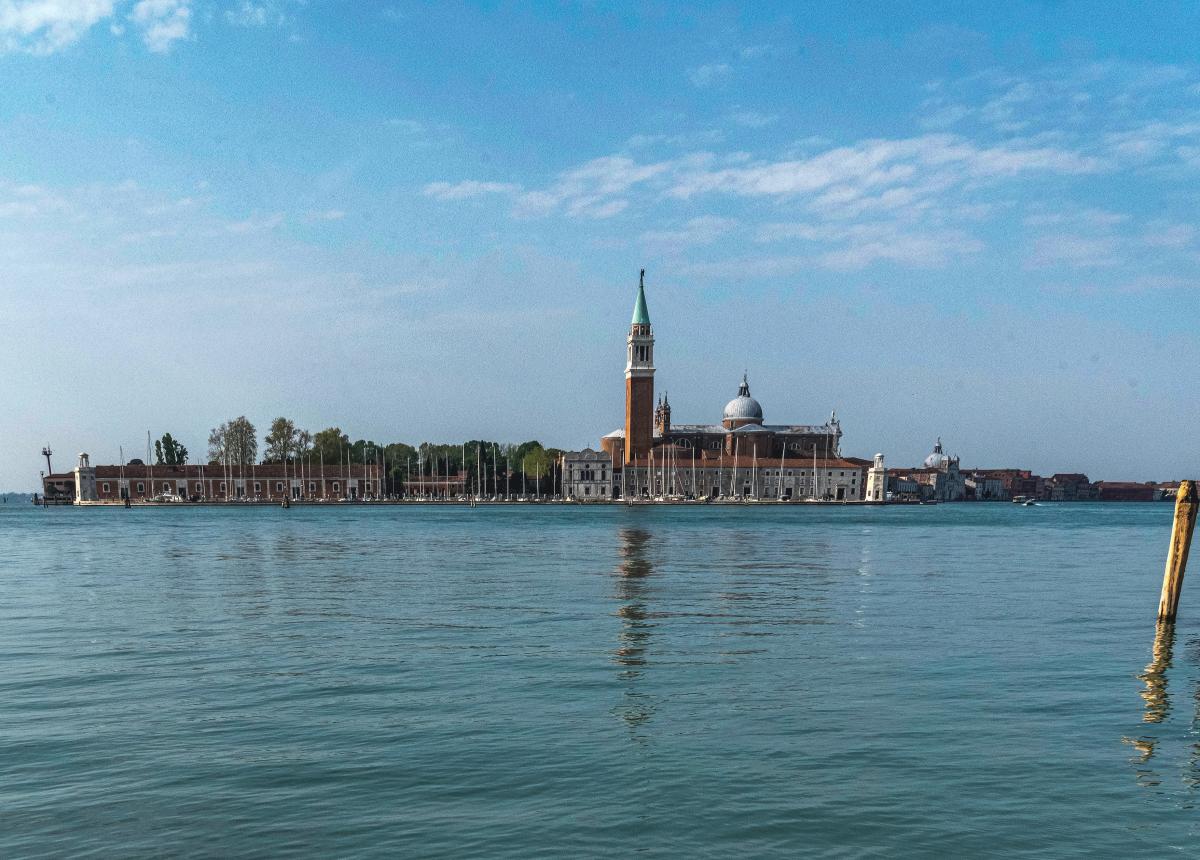
The island of San Giorgio Maggiore with its abbey and bell tower
Sources
- Guida Rossa Touring Club Italiano. 2005. Venezia. La biblioteca di Repubblica
- Giulio Lorenzetti – Venezia e il suo estuario, 1974
- 1999. Calli, Campielli e Canali – Guida di Venezia e delle sue isole. Edizione Helvetia
- Marina Crivellari Bizio. 2009. Campi Veneziani – Storia e segreti dei campi veneziani. Filippo Editore Venezia
- Mariagrazia Dammicco. 2013. Guida ai Giardini Veneziani. La Toletta Edizioni.
- Visite guidate e non in alcuni punti di interesse tra i quali chiese, musei, mostre e botteghe di artigianato etc.
- Consultazione dei siti ufficiali dei principali punti di interesse
- https://www.comune.venezia.it/
- https://www.veneziaunica.it/



